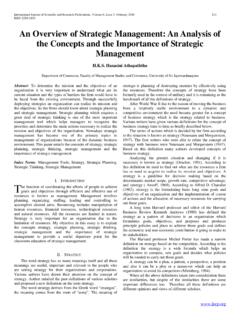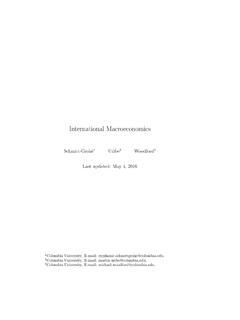Transcription of The evolution, processing, varieties and health benefits ...
1 international journal of Scientific and research Publications, Volume 4, Issue 4, April 2014 1 ISSN 2250-3153 The evolution, processing, varieties and health benefits of yogurt Weerathilake*, Rasika*, Ruwanmali* and Munasinghe** * Department of Livestock & Avian Sciences, Faculty of Livestock Fisheries & Nutrition, Wayamba University of Sri Lanka, Makandura, Gonawila 60170, Sri Lanka **Faculty of Agriculture, University of Peradeniya, Peradeniya 20400, Sri Lanka Abstract- Yogurt or yoghurt is one of the most popular fermented dairy products worldwide which has great consumer acceptability due to its health benefits other than its basic nutrition. In general, yogurt is considered as a nutrition-dense food due to its nutrient profile and is a rich source of calcium that provides significant amounts of calcium in bio-available form.
2 In addition, it provides milk proteins with a higher biological value and provides almost all the essential amino acids necessary to maintain good is considered as a probiotic carrier food that can deliver significant amounts of probiotic bacteria into the body which can claim specific health benefits once ingested. These are usually marketed as bio-yogurts. Moreover, yogurt is reported to claim improved lactose tolerance, immune enhancement and prevention of gastrointestinal disorders. Because of these known health benefits of yogurt,consumer demand for yogurt and yogurt related products has been increased and became the fastest growing dairy category in the global market. Yogurts are now being manufactured in a numerous styles and varieties with different fat contents, flavors and textures suitable for different meal occasions and plates as a snack, dessert, sweet or savory food.
3 Index Terms- bio-yogurt; health benefits ; probiotics; yogurt I. INTRODUCTION ogurt is one of the most popular fermented dairy products which has a wide acceptance worldwide whereas its nutritional and health benefits are well known for centuries. The origin of yogurt is dated back to the 6000 when the Neolitic people in the Central Asia transformed from a status of a food gatherer to a food producer where they began the practice of milking their animals. It is generally accepted that the fermented milk products including yogurt have been discovered accidentally when they used to store milk in sheep-skin bags and has been evolved over centuries into commercial yogurt making which paved the pavement for different commercially available varieties with a range of flavors, forms and textures [1, 2].
4 According to the Code of Federal Regulations of the United States Food & Drug Administration (FDA), yogurt can be defined as a food produced by culturing one or more of the optional dairy ingredients namely, cream, milk, partially skimmed milk, and skim milk, used alone or in combination with a characteristic bacterial culture that contains lactic acid producing bacteria, Lactobacillus bulgaricus and Streptococcus thermophilus [3].Yogurt should contain at least of milk fat and of Milk Solids Non Fat (MSNF) with a titratable acidity of not less than percent, expressed as lactic acid [3]. The composition requirement for milk fat and MSNF is applied to the yogurt prior to the addition of bulky flavoring ingredients according to the USDA specifications for yogurt [4].
5 Traditionally yogurt is made of cow, water buffalo, goat and sheep milk. However, milk from mare and camel is also used in yogurt making in some of the regions in the world. According to the available literature, it can be suggested that the health benefits associated with yogurt consumption is well known for centuries [5, 6, 7].Yogurt is considered as healthy food due to its high digestibility and bioavailability of nutrients and also can be recommended to the people with lactose intolerance, gastrointestinal disorders such as inflammatory bowel disease and irritable bowel disease, and aids in immune function and weight control [8, 9]. Because of these health benefits associated with yogurt consumption, there is an increasing trend for yogurt and is the fastest growing dairy category in the market in particular, standard yogurt and yogurt drinks [10].
6 Moreover, yogurt represented $51 billion in global spending in 2011, whereas Switzerland and Saudi Arabia were among the leading per head yogurt consumers globally that accounts for and kg of yogurt per head per year in 2008 [11]. The history of yogurt, manufacturing process, varieties and types of yogurts available in the market, and its associated health benefits are reviewed in this article. II. HISTORY OF THE YOGURT MAKING Milk fermentation is one of the oldest methods practiced by the human beings to preserve milk with an extended shelf life. The exact origination of milk fermentation is not clear; however, it seems that it is dated back to the dawn of the civilization. It has been reported that the early civilizations such as the Samarians, Babylonians, Pharoes and Indians were well advanced in agricultural and animal husbandry practices [5].
7 This can be supported by the findings of Copley et al., 2003 in which the dairy fat residues were found in pottery fragments from Neolitic Bronze-age and Iron-age settlements, which suggests that the practice of dairying had existed in Britain approximately 6500 years ago [12]. However, it is questionable that the milk fermentation was practiced during this period. Therefore, the origination of the fermented milk products including yogurt Y international journal of Scientific and research Publications, Volume 4, Issue 4, April 2014 2 ISSN 2250-3153 remains unsolved. It has been reported that the Anatolian goatherds conserve their milk by thickening as they used to dry it in the sun and transport in animal stomachs[6]. It is generally accepted among the historians that the fermentation of milk is discovered accidentally by the Neolithic people of Central Asia when they stored milk in primitive methods such as in sheep-skin bags in warm climates [7].
8 With reference to yogurt, it can be suggested that it has been evolved in Turkey as the term yoghurt has been derived from a Turkish verb, jugurt that means to be curdled or coagulated [5, 7]. The earliest writings about yogurt can be found from those of Pliny who lived in the first century A. D. and wrote about ancient barbarous nations that knew how to thicken the milk into a substance with an agreeable acidity. According to the literature, the founder of the Mongol empire, Genghis Khan and his armies was lived on yogurt and spreading of this news among the people had made theyogurt consumption to spread throughout the East [7]. Moreover, according to the Persian tradition, Abraham owed his fecundity and longevity to the regular ingestion of yogurt, and the emperor Francis I of France was said to be cured of severe diarrheaby consuming yogurt made of goat milk leading to introduce the health benefits of yogurt into the western world in 1542 [5, 6].
9 The first industrialized production of yogurt was taken place in 1919, in Barcelona, Spain at a company named Danone[7]. Yogurt was firstly introduced to the USA in the early 20th century in the form of tablets especially designed for those with digestive intolerance [6]. However, it became popular in the North America when Dannon, a small-scale yogurt factory started manufacture of yogurt in New York in 1940. Even though, yogurt has been evolved for centuries, it was subjected to a significant and dynamic evolution process in the 20th Century to originate a vast array of instance, fruit yogurts, yogurts with fruit on bottom and blended yogurts were introduced in 1937, 1947 and 1963 respectively[6, 7]. It seems that the evolution process of yogurt has taken place in different regions of the world once it had been originated in the Central Asia.
10 This might be the reason of having different types of yogurts and yogurt-like products in different names which are summarized in the Table 1. Table 1 Yogurt and yogurt-like products originated in different regions of the world Region Country/island or region of origin Traditional name of the yogurt or yogurt-like product Europe Turkey Jugurt/eyra/ayran Balkans Kisselmleka/naja/yaourt Balkan mountains Urgotnic Greece Yiaourti Italy Cieddu Sicily Mezzoradu Sardinia Gioddu Hungary Tarho/taho Finland Viili Scandinavia Filmjolk/fillbunke/filbunk/surmelk/taett em Iceland Skyr Yugoslavia Gruzoviz Portugal Iogurte Eurasia Russia Donskaya/varenetes/kurugna/ryzhenka/gusl yanka Turkestan Busa Transcaucasia (South Caucasian state was once extended across the modern-day countries of Armenia, Azerbaijan, and Georgia)














